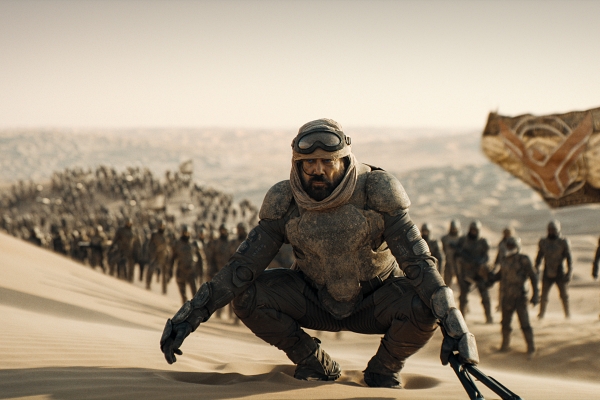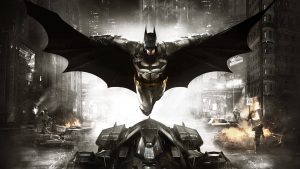
Denis Villeneuve is nothing short of a living maestro. No other working director can so skillfully transmogrify a heralded text into a jaw-dropping exercise in both art and commerce, making for a sci-fi epic that’s as artistically entrancing as it is nonstop thrilling. A masterclass in world expansion, Dune: Part Two picks up where the last chapter, released simultaneously in theaters and on HBO Max in the doldrums of the lingering pandemic in 2021, left off while continuing to complicate the world of Arrakis, its mythology, its peoples, and what’s at stake for the entirety of Frank Herbert’s well-drawn universe. Villeneuve’s eleventh feature film presents a triumphant middle chapter that grapples with inner darkness, ruminative notions of prophecy and destiny, romantic entanglement, and familial tragedy in what is set to be one of the great trilogies and a true modern masterwork.
Following the culling of House Atreides by rival Great House Harkonnen, Paul Atreides (Timothée Chalamet) and his Bene Gesserit mother Jessica (Rebecca Ferguson) have joined ranks with Arrakis natives, The Fremen. Whispers of the prophecy of Lisan Al Gaib, The Voice from the Outer World, amplify as Paul learns the ways of the desert folk from the devout Stilgar (Javier Bardem) and the skeptical but warming Chani (Zendaya). Sandwalking, wormriding, and water harvesting are just a few of the ways that the Fremen survive in such inhospitable conditions and Villeneuve pays great attention to the smallest detail, pursuing the cardinal filmmaking virtue of showing rather than telling. The architecture of his filmmaking is rich with choices, leaning on film grammar that emphasizes visual language as much as narrative exposition. It’s a tremendous way to draw audiences in and force their engagement, Dune: Part Two a towering storm of audio-visual majesty that’s impossible to turn away from for even a moment.
The ways of the desert apply also to Fremen military campaigns with Paul and the Fremen besieging spice harvest operations with guerrilla warfare tactics in order to disrupt the galactic wheels of commerce and draw the Emperor (Christopher Walken), surreptitiously responsible for his father’s demise, more directly into the conflict on Arrakis. Meanwhile on the duochromatic, industrialized planet of Giedi Prime, Harkonnen Baron (Stellan Skarsgård) turns to his ruthless nephew Feud-Rautha (Austin Butler) to tame the uprising on Dune in a bid to take over the Emperorship for his bloodline. The script from Villeneuve and Jon Spaights invests in the turmoil between houses as well as within them, weaving webs of possibility that suggests greater depth and complication than the story’s otherwise linear story of underdog chosen one ascendancy. With another Dune chapter on the horizon, it’s impossible to say which of these threads will bear fruit but Villeneuve and Spaights belly enough political intrigue into each character exchange that they take on value divorced from their impending implications to the plot.
All roads lead to Spice, a psychedelic substance used for increased vitality, consciousness-expansion, and space travel. As the opening crawl of the movie tells us, he who controls the spice, controls the universe. It’s basically space LSD crossed with interstellar gasoline and Paul’s increased exposure to the spice leads to visions of a future he cannot bear but also cannot prevent. Dune: Part Two grapples with the weight of prophecy through Paul, who ostensibly wants to help free the Fremen so that they may lead themselves, despite his mother’s insistence that he is the fated and foretold Lisan Al Gaib, destined to rule Arrakis and its people. The film also challenges the idea of religious fervor and its power to manipulate, with Ferguson’s character working the weak minds of the masses, laying the groundwork for Paul’s ascendancy. The more that characters like her turn towards power and faith (the two completely intertwined in this universe), the less recognizably human they become.
This dynamic is explored within Paul and Chani’s emergent relationship. Paul is unable to resist the pull towards Chani’s hesitant Fremen affection and yet, on a grander metaphysical scale, he’s acutely aware of the devastation and sacrifice that awaits him, his allies, and his people with each decision on the desert planet. Their relationship grounds his transformation from rebellious warrior to burgeoning leader, with Paul’s increased cognizant of his destiny further clouding his affections. Religious overtones inject a further fervor that threatens to transform Paul from a committed cog of the collective into a messianic iron fist. Villenueve captures this romance against the blistering backdrop of Dune’s expansive desert wasteland, underscoring their solitary unity before thrusting them into battles with enemies and from within. If for only a moment, it’s them against the world.
A thundering score from Hans Zimmer and simmering cinematography from returning DP Greig Fraser are the most immediately recognizable production elements that burst off the screen but every single aspect of Dune: Part Two scorches with brilliance. Patrice Vermette’s considered production design, Jacqueline West’s sharp and utilitarian costumes, and Shane Vieau’s expansive sets all contribute to Dune’s epic scope, giving rare potent artistry to what could have been a vacuous exercise of genre. As more and more studios turn towards existing IP in order to maximize shortcut profits, Villeneuve’s Dune franchise should serve as a template for how to do so thoughtfully. Some in the audience may gripe that Dune: Part Two builds slowly, a symptom of blockbuster mainstays following algorithmic storytelling patterns, but there isn’t a single subplot or steady slo-mo gaze into a sand-blasted dunescape that doesn’t add to the building mythology of this story.
A steely-blue-eyed Chalamet handily leads the cast, his chemistry with Zendaya’s Chani, in a much expanded role from Part 1, the human foundation for the sociopolitical war games to unfold atop of. The supporting cast is truly a remarkable assemblage of A-cast talent, one of the finest ever congregated for a tentpole film (or really any film for that matter), with the aforementioned cast as well as Josh Brolin and Charlotte Rampling returning and the addition of Florence Pugh, Léa Seydoux, and a blink-and-you’ll-miss-it cameo from Anya Taylor-Joy capping off a real who’s who of Hollywood talent. Of the newcomers, Austin Butler’s ferocious turn as the Harkonnen heir apparent pops most. From his stark, sharp, eyebrow-shaven physicality to his growling vocal fry, he’s an imposing antagonist, even if all his striking build up ultimately results in a bit of short shrift come the last act. Javier Bardem, as a devout Fremen warrior-leader, is also a standout.
Those left unfulfilled by Part One’s open-ended, “to be continued…” nature will find similar complaints with Part Two, as Villeneuve and his creative team have once again decidedly not shut the book on this story. So much so that the journey would feel unequivocally incomplete without a third film in the trilogy to wrap up the many open narrative threads. As someone who could spend untold hours watching Villeneuve further spin out this world, its mythologies, politics, and characters, that seems more an otherworldly promise than a threat.
CONCLUSION: ‘Dune: Part Two’ further opens the book on the world of Paul Atreides and Arrakis in this towering accomplishment that’s as thrilling as it is stunning to watch, hear, and feel. Watch it on the biggest screen you can find.
A
Follow Silver Screen Riot on Facebook
Follow Silver Screen Riot on Twitter
Follow Silver Screen Riot on Instagram
The post Towering ‘DUNE: PART TWO’ An Artful Masterclass in World Expansion appeared first on Silver Screen Riot.






